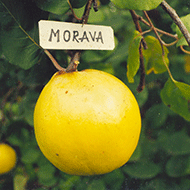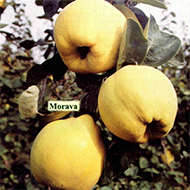Morava
It derived from a cross of 'Reans Mamouth' and 'Leskovačka'. The hybridization was carried out in 1967 and it was named and released in 1987. The breeders are prof. Dr. Asen Stančević and Anica Mutapović, BSc in agriculture.
The tree is medium vigorous (slightly more developed than quince 'Leskovačka'), with a roundish crown and strong shoulders growing at an angle of 60°. The shoots are medium thin, light brown and slightly glossier than those of 'Leskovačka'. It produces numerous short spear like fruiting branches, bearing also considerable crop on shortened one-year-old shoots. The buds are small, acute and appressed. The leaves are medium-sized, roundish-oval, unserrated. The veins are moderately expressed. The undersides are covered with fine whitish pubescence. The flower is medium large to large, highly prominent, white, hermaphrodite, with pronounced pistils. This is an early-flowering cultivar and the flowering lasts 6−8 days producing abundant pollen of good germination ability. It is self-fertile, regular and abundant cropper of early flowering time.
The fruit is large to very large, (330 g on average), roundish-oval, smooth and even. The calyx is medium-sized, sunken in a deep ribbed basin. The skin is thin, smooth and glossy, lemon-yellow to straw-yellow over the entire surface and covered with fine greyish pubescence. The flesh is yellowish, firm, compact, crisp, finely grained, slightly subacid, of a refreshing flavor and highly aromatic. Fruit can be maintained until the end of March retaining juiciness and without tissue browning. It contains 13% soluble solids, 0.2% tannins and 0.7% pectin. The core is small to medium, roundish-oval, placed in the middle of the fruit, housing 45−50 seeds per fruit. The seeds are small to medium-sized, beaky and flat. The stalk is very short (about 5 mm) and set on the fruit surface or in a small ribbed cavity typical of this cultivar.
It is picked in early October, somewhat earlier than 'Leskovačka' and 'Vranjska'. It is stored all through to late March with no juice losses and it is not prone to tarnishing, which is an important advantage in comparison with other cultivars.
A quince cultivar with high-quality fruits and long storage life. An excellent cultivar that should be grown more widely.

 English
English Srpski
Srpski 

